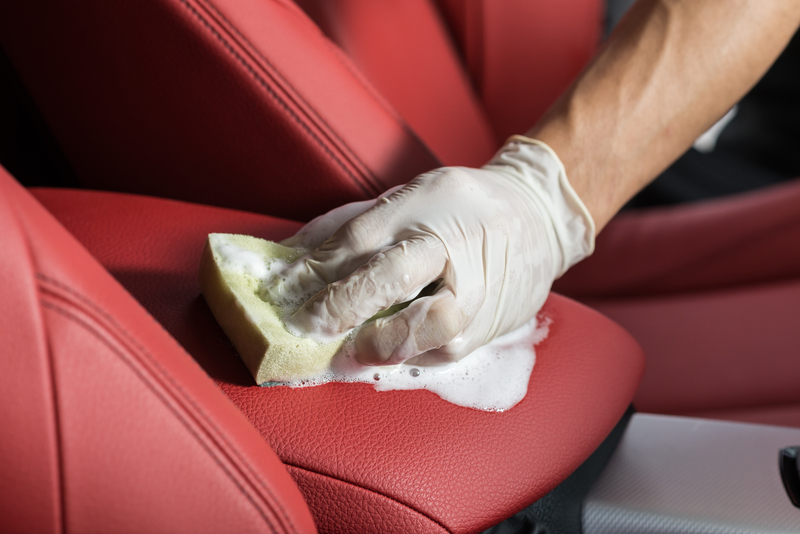Transform Your Home: Eliminate Damp Odors
Posted on 20/06/2025
Transform Your Home: Eliminate Damp Odors
Are you tired of that persistent musty smell lingering in your home? Eliminating damp odors is crucial not only for your comfort, but also for your health and the integrity of your property. Damp odors can indicate hidden moisture problems, mold growth, or ventilation issues--all of which, if ignored, can lead to serious consequences. In this comprehensive guide, we will cover everything you need to know to eliminate damp odors and transform your home into a fresher, healthier, and more inviting space.
Understanding Damp Odors: What Causes the Musty Smell?
Before diving into solutions, it's important to understand the root causes of damp odors. The musty smell that invades many homes often stems from excess moisture, leading to the growth of mold, mildew, and bacteria. These microscopic culprits release volatile organic compounds (VOCs) that produce the characteristic dank fragrance.
Common Sources of Moisture and Damp Odors:
- Leaking pipes or roofing
- Poor ventilation in bathrooms, kitchens, or basements
- Condensation on walls, windows, and ceilings
- Wet carpets, upholstery, or building materials
- Flooding or high humidity environments
If you detect damp or musty odors, addressing them early can prevent expensive repairs and protect your family's health. Let's explore effective techniques to eliminate damp odors for good.

Step 1: Identify the Source of Dampness
The key to removing any unpleasant smell is to go directly to the source. Here's how to find and address dampness in your home:
- Inspect under sinks and around pipes for signs of leaks, rust, or water stains.
- Examine walls and ceilings for discoloration, bubbling paint, or peeling wallpaper--indications of moisture behind surfaces.
- Check floors and carpets for dampness, especially after heavy rain or in areas that feel unexpectedly cool or clammy.
- Look for visible mold, often appearing as black, green, or white patches, especially in corners and behind furniture.
- Sniff out mustiness in closets, basements, or attics, which are prime breeding grounds for damp odors.
Once you've pinpointed the problem area, address any active leaks or moisture sources immediately. Permanent odor removal depends on fixing the underlying cause first.
Step 2: Improve Home Ventilation
Poor airflow is a common contributor to damp and musty odors. Good ventilation helps moisture escape and prevents it from seeping into porous surfaces. Here's how to boost airflow in your home:
- Open windows and doors regularly to allow fresh air to circulate, even in colder months for short periods.
- Install exhaust fans in moisture-prone areas, such as kitchens, bathrooms, and laundry rooms.
- Use ceiling fans to keep air moving and prevent stagnant pockets of dampness, especially in basements or attics.
- Keep furniture and textiles away from walls so air can freely move around and dry out surfaces.
If your home suffers from persistent humidity, consider a whole-house ventilation system for ongoing moisture control.
Step 3: Dehumidify Damp Spaces
Since excess moisture is the primary cause of musty odors, controlling humidity is essential. Dehumidifiers are an effective solution, especially in areas prone to dampness:
- Place dehumidifiers in basements, bathrooms, laundry rooms, or anywhere moisture gathers.
- Set humidity levels below 60%--ideally between 30% and 50%--to inhibit mold and mildew growth.
- Regularly empty and clean dehumidifier tanks to prevent bacterial buildup and ensure efficient operation.
For smaller spaces, desiccant packs or moisture absorbers (like silica gel or activated charcoal) can help soak up humidity and neutralize odors.
Step 4: Remove Mold and Mildew Effectively
If mold or mildew is present, it must be eradicated to eliminate the source of damp odors. Here's how to tackle the problem safely:
- Wear protective gear: Use gloves, a mask, and goggles to avoid exposure to spores.
- Scrub hard surfaces: Clean walls, floors, and tiles with a mixture of water and white vinegar, or use a commercial mildew remover.
- Launder contaminated fabrics: Wash affected clothing, curtains, and bedding in hot water with baking soda or vinegar.
- Replace porous materials: Carpets, ceiling tiles, and drywall with extensive mold may need to be removed and replaced.
- Dry thoroughly: After cleaning, ensure surfaces and fabrics are completely dry to discourage mold regrowth.
*For extensive mold infestations, consult a professional remediation team to prevent health risks.*
Step 5: Deep Clean to Eradicate Lingering Odors
Once moisture and mold are under control, it's time to deep clean your home to remove embedded damp odors:
- Steam clean carpets and upholstery to kill hidden bacteria and remove trapped smells.
- Wash walls and tiles with a mold- and mildew-fighting cleaner.
- Launder soft furnishings: Remove and wash throw pillows, blankets, drapes, and linens.
- Air out rooms and furnishings by placing them outside on a dry, breezy day.
These steps will go a long way toward restoring a fresh, clean scent to your home.
DIY Solutions to Neutralize Musty Odors
In addition to cleaning and dehumidifying, try these simple, natural remedies to neutralize stubborn damp smells:
- Baking soda: Place bowls of baking soda around the room to absorb odors.
- Activated charcoal: Known for its odor-trapping abilities, charcoal can be tucked into corners and closets.
- White vinegar: Set out a bowl of vinegar to banish odors or add it to your cleaning routine.
- Essential oils: A few drops of tea tree, lavender, or eucalyptus oil can mask unpleasant odors and even inhibit mold growth.
- Coffee grounds: Place fresh coffee grounds in a container to absorb bad smells in smaller spaces.
Rotate or refresh these odor-fighting materials regularly to keep your home smelling clean.
Preventing the Return of Damp Odors
Once you've worked hard to eliminate musty odors, keep them from coming back by following these long-term prevention strategies:
- Fix leaks immediately: Stay vigilant for new plumbing, roof, or window leaks.
- Maintain ventilation: Run exhaust fans and keep airflow consistent year-round.
- Use moisture barriers: In basements or crawl spaces, install vapor barriers to keep ground moisture at bay.
- Monitor indoor humidity: Use a hygrometer to keep humidity in the recommended range of 30-50%.
- Declutter regularly: Clean and organize storage spaces so air can circulate, and avoid storing items directly against exterior walls or floors.
Health Risks of Untreated Dampness and Musty Odors
Unchecked dampness in the home isn't just unpleasant--it can be dangerous. Prolonged exposure to mold, mildew, and excess moisture increases the risk of:
- Allergies and respiratory issues (asthma, coughing, and sinus infections)
- Sinus problems and skin irritation
- Damage to structural components and interiors
- Decreased property value due to visible damage or persistent odors
That's why it's essential to eliminate damp odors right away and prevent further issues before they escalate.
Choosing the Right Products for Damp Odor Removal
There are many commercial options available to help you banish musty smells and keep them from coming back:
- Moisture absorbers: Products containing silica gel, calcium chloride, or clay are perfect for closets, pantries, and small spaces.
- Dehumidifiers: Choose models with size-appropriate capacities and easy maintenance features for your living area.
- Enzymatic cleaners: These break down organic sources of odor at a molecular level--ideal for pet accidents or musty fabric.
- Mold and mildew sprays: EPA-approved cleaners for safe and effective treatment.
- Odor-sealing primers: Use sealant paints to lock in lingering smells on primitive surfaces after cleaning.
Always follow manufacturer's instructions and keep cleaning solutions out of reach of children and pets.
When to Call a Professional
Some damp odor situations require expert intervention:
- Large-scale water damage: Flooding, sewage backups, or extensive leaks that impact multiple rooms.
- Pervasive mold growth: Recurring or widespread mold infestations behind walls or within HVAC systems.
- Persistent structural dampness: Moisture or musty smells that return despite your best DIY efforts.
Professional remediation teams have specialized equipment and knowledge to restore your home to a safe, healthy condition.

Frequently Asked Questions About Eliminating Damp Odors
-
How long does it take to eliminate damp odors?
Small problems can be resolved in a day or two with cleaning and ventilation. Larger issues, such as widespread mold, can take a week or longer and may require professional help. -
Can air fresheners hide musty smells?
They may temporarily mask odors, but only by removing the source of moisture and cleaning thoroughly can you truly eradicate damp smells from your home. -
Will painting over musty walls help?
No. Painting over damp, uncleaned walls can trap odor and moisture inside, which can cause the problem to worsen over time. -
Is it safe to use bleach to remove mold and mildew?
Bleach can disinfect hard surfaces but is less effective on porous materials and can produce toxic fumes. Natural alternatives like vinegar are often safer for indoor use.
Conclusion: Create a Home That Looks, Feels, and Smells Healthy
Transforming your home by eliminating damp odors is a vital step in maintaining a healthy, comfortable, and inviting living environment. By identifying the causes of musty smells, implementing both immediate and long-term solutions, and keeping up with regular maintenance, you can banish damp odors--and their associated health risks--for good.
Whether you're tackling a musty basement, dealing with odors after a leak, or simply want to ensure indoor air quality, these tips will help you enjoy a fresher, healthier, and more welcoming home year-round.
Your home is your sanctuary--make it smell like one.





